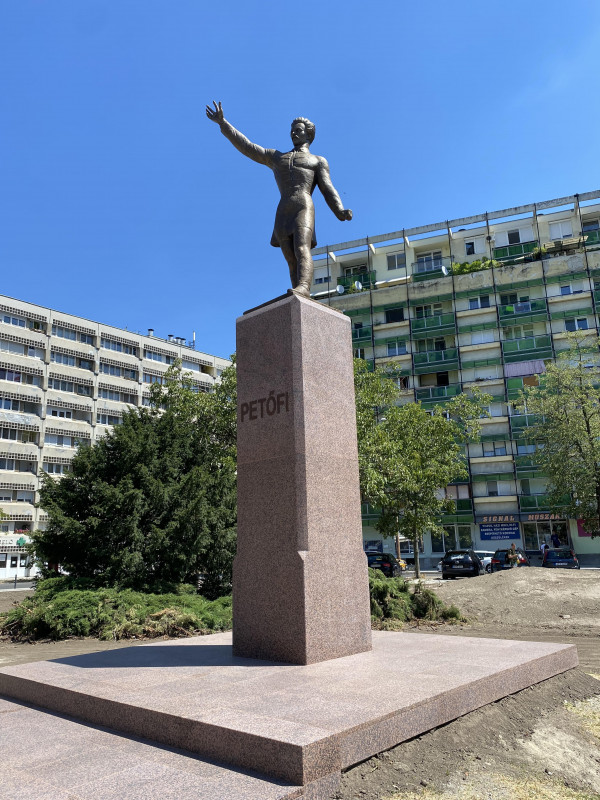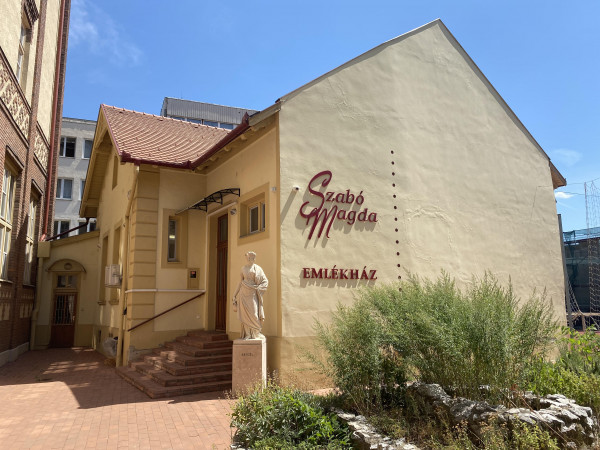I am Ag Apolloni, writer from Kosova, and professor at University of Pristina. On 15th of July (2022), I came in Debrecen as a writer in a one-month residence. Here I began writing the novel "Red Riding Hood, a tale for the adults", and at the meantime I go around the town, I read at the park, I buy any book in English of any Hungarian writer, I take pictures of the city, buildings, statues etc., trying to take the best of it, so I can have it with me even when I am not here anymore.
As a writer I find comfort here. I have known Hungary a little. Expect Attila the Hun, whom is known from everyone, I know Sándor Petőfi, Attila József, Béla Bartók, Imre Kertész, Péter Esterházy, Ágota Kristóf, Béla Balázs, László Nemes too, and maybe any other as well. Still, not as much as I would like to.
Regardless, my stay here is to get to know the culture better, and the history of this place, where I first passed by as a child, but never stopped. Precisely in the early 90s, while all my known family members were trying to flee illegally to Germany, an attempt that failed near the Czech-German border. All I keep in my mind from that time, when looking out the bus window is: flat fields, orchards, some women weaving baskets from sticks, ships and a long bridge over a large river called Danube. I had never seen a navigable river, seas and oceans are not even to be mentioned.
Now, while here, I am impressed by the calmness of the city and its people’s warmth. On the streets I see beautiful faces, I hear a soft language, cars always give priority to pedestrians, even when he or she has not yet approached the zebra crossings. Now I know why Magda Szabo loved this place that much, which has paid tribute to her by erecting a statue of her in the central square, making a memorial museum for her, and naming a pedestrian street after her.
First picture: I was wandering around, when suddenly at the left of the road my eyes caught Petőfi’s statue. One hundred and eighty years before, the national Hungarian poet, Sándor Petőfi came in Debrecen feeling down, luckily with its friends care he got back. Few years lwter, he died in the battle, at the age of 26 years. Somewhere around 26 years ago, I have known this poet, at my hometown library, when I read “Challenge to the Kings” (a collection of his poems, translated by Nonda Bulka, Dritëro Agolli and others) I was impressed by his verses as much I was impressed by his life. Petőfi wrote something I was never able to forget: “For my love, I’ll sacrifice my life. For liberty, I’ll sacrifice my love.”

Second picture: I had never heard of Lőrinc Szabó. When I first saw his statue at the main square, I would think it is John Lennon. Surely, when I got closer, I understood it was not. Méhes Károly presented him to me, and suggested me some of his poems.
Third picture: I was at the park reading the work of Hungarian academic Maria Tatar from the Harvard University, The Classic Fairy Tales, when I noticed a statue and straightly went near it and took a picture. It was Lőrinc Szabó with his book closet behind. I translated in Albanian language “Lóci writes a poem” with a note for the Albanian readers: Lőrinc Szabó was a modern Hungarian poet. He finished his school in Debrecen. He translated Shakespeare, Goethe, Baudelaire and Nietzsche etc. He died from heart attack at the age of 50 years.
This was one of his poems dedicated to his son, Lóci. I liked the simplicity and the depth of it, so I translated it (from English). The statue that you can see in the picture is at Nagyerdei Park.
Fourth picture: I knew Magda Szabo, but while in Debrecen you feel her closer. Seeing Debrecen filled with Magda (museum, statue, memorial plaque, street name etc.), you fall for her and her city. I took this picture of the city square in 17th of July, afternoon when I was heading back from the park.
Fifth picture: I took this picture when I was wandering around the park, where I go everyday to take fresh air and think about my new novel. I think better while walking. I am a peripatetic person.
Sixth picture: This picture was taken after my morning walk at the park. At the museum, there was a cute girl that when she noticed I do not speak Hungarian, went and found me some English papers that explained the concept of the memorial museum.

Pictures 7-8: I photographed the plaque and the door on a Sunday, when museum was closed and I couldn’t go in. As I was taking the picture, I stood there a few minutes, because there at the corner were two old ladies talking. I was curious to listen. This way, in this language, Magda once talked with her friends.
